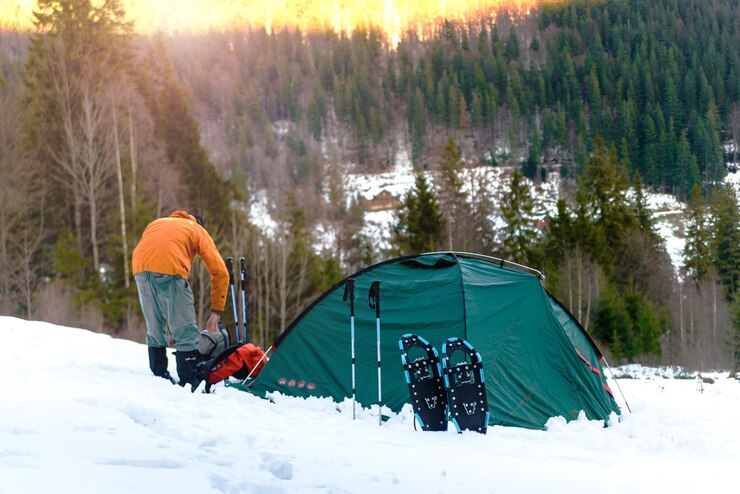
Table of Contents
Introduction
Camping and Hiking Fall Foliage Adventures: Hike the Best Autumn Trails to Capture Nature’s Beauty Hiking and Winter Camping: Autumn is just like a grand finale in nature’s big show. The temperature starts to dip, air becomes crisp, and the landscapes transform into riotous splashes of red, orange, yellow, and gold. For the outdoors enthusiast, hiking during the fall foliage season is almost a sensory joy:
A visual feast accompanied by the crunch of fallen leaves below you and a hint of earthy smell in the air. But if you want to truly immerse yourself in the season, let’s explore some of the best hiking trails for stunning fall foliage, how to prepare, and everything you need to know about winter camping when the chill starts to bite. This guide is here to ensure that your autumn outdoor escapades are never to be forgotten!
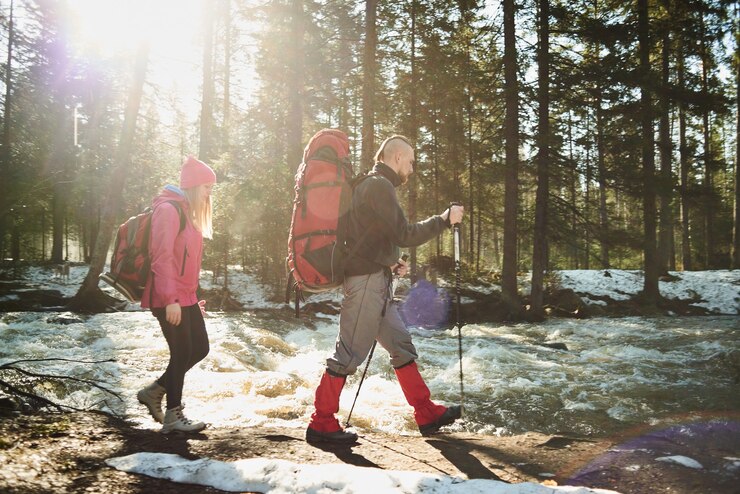
Best Hiking Trails for Stunning Fall Foliage
Blue Ridge Parkway, Virginia & North Carolina (USA)
This route is often cited as one of the greatest routes for fall views, but there are paths that branch off which give you an even more intimate sense of vibrant forests. The peaks of Humpback Rocks deliver panoramic views of hills draped in fiery reds and burnt oranges.
Best time to visit: Mid-October.
Mont-Tremblant National Park, Quebec (Canada)
Mont-Tremblant is at its kaleidoscope of colors when autumn arrives. Trails such as La Roche provide an extraordinary view of the Laurentian Mountains. The amalgamation of sugar maple, birch, and beech trees creates a kaleidoscope of warm colors.
Best time to visit: Late September to early October.
Lake District, Cumbria (United Kingdom)
The Lake District is a golden, amber, and russet tree tapestry reflected in mirror-like lakes. Such trails as the Catbells Walk offer moderate climbs and fantastic views of Derwentwater surrounded by autumn splendor.
Best time to visit: Early to mid-October.
Mount Rainier National Park, Washington (USA)
The Nisqually Vista Trail and Skyline Trail offer eye-catching color scenes from the stand of vibrant huckleberry bushes and golden meadows framed in contrast with snow-capped peaks.
Best time to visit: Last week of September to first week of October.
Nikko National Park, Tochigi Prefecture (Japan)
Nikko transforms into a fairy tale landscape in fall. A mostly oneway line along the Kanmangafuchi Abyss, lined with statues, and colorful fall leaves creates an enchanted walk without being in any way frenzied. Very serene.
Best time to visit: Mid to late October
Schwarzwald (Black Forest), Germany
The Black Forest offers magical woods and panoramic views. Lothar Path is just one of the beautiful trails that take you through rolling hills which are all covered in fall colors.
Best time to visit: Late October to early November.
Great Smoky Mountains, Tennessee & North Carolina (USA)
The Smokies exhibit over a 100 species of native trees, which in turn leads to one of the most fantastic fall foliage displays. Trails like Alum Cave Trail lead to colorful views of peaks and valleys.
Best: mid-October to early November
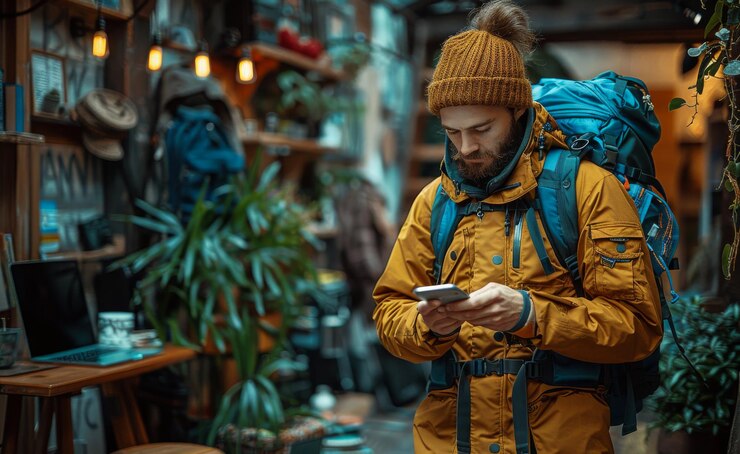
Planning a Fall Foliage Hike
Planning an autumn leaves hiking trip is greatly rewarding because it can present breathtaking views and, above all, immerse one in the pulsating colours of nature. To make sure your adventure is both enjoyable and memorable, here’s a detailed guide that can help you understand and prepare for every aspect of your trip.
Time It Right
The timing of fall foliage is all important. Various regions peak at different times. Here is a general overview:
Northern regions, as in New England, tend to peak in late September and mid-October.
The Midwest regions usually peak mid- to late October.
- Peak viewing times for the southern states should be towards late October to early November. Research the peak date for your destination by going through the local tourism board or online foliage maps to get it right, as the goal is to catch the colors at their best.
Check the Weather
Autumn weather can often be unpredictable and sometimes warm and sunny one day and then icy, rainy, or even snowy the next. Layering is the best way to prepare for changing temperatures. Pack:
Moisture-wicking base layer that prevents sweat from sticking to your skin
An insulating middle layer such as a fleece that keeps you warm.
- A waterproof, breathable outer layer for the protection of winds and rains. In this way, you have the choice of building or peeling off layers during the hike as the weather may dictate so.
Be an Early Bird
Fall is a popular time to hike so there will be many other people on the trails, especially during the weekend and when the fall colors are at their peak. Arriving extremely early will not only help you miss crowds of hikers but also get you to the trail before dawn breaks so you can enjoy stunning sunrises. You will also ensure that you finish your hike when it is still light.
Bring a Camera
The red, oranges, and yellows of fall are fantastic and worth taking pictures for themselves. Compact DSLR cameras, mirrorless, even a good smartphone with nighttime exposure can work miracles. Just for the sake of quick shot guidance:
- Play with reflections on water surfaces.
- There should be an interesting photo possibility in the path paved of colorful trees.
- Use the golden hour (shortly after sunrise or before sunset) for the best lighting.
- Capture close ups of individual leaves to highlight the tiny details and colors.
Stay Hydrated and Energized
It’s easy to forget to drink in the cooler months, but hydration in fall hikes is just as essential as it is in summer. Even on cool days, dehydration can occur and sometimes is harder to detect. Pack lots of water and consider bringing a hydration pack to be ready. And keep your energy up with high-calorie snacks like nuts, dried fruit, energy bars, and trail mix.
Be Aware of Wild Animals
Fall is an active season for many animals that prepare themselves to face the aggressive weather and hard winters that are going to come. You might encounter deer, bears, squirrels, or birds while hiking, depending on the area in which you’re hiking. To have a safe hike and enjoy your pleasurable hiking experience:
- Observe their space and keep a distance.
- Make noise during your hike by talking or with a bell to not surprise them.
- Store food safely and adhere to the leave no trace principles to avoid attracting wildlife to campsites
Be AWARE of Daylight Hours
As the fall season progresses, the days are shorter and daylight hours continue to shorten. You will not have as much time before twilight sets in to complete your day hikes. Determine your route so you can finish up by sunset without getting stuck in the dark. Always pack a headlamp or flashlight plus some spare batteries, in case you end up needing some supplemental light.
Brief Summary of Recommendations:
- Hike when foliage is at its peak
- Dress in layers in case the weather turns sour.
- Prepare to arrive early to avoid crowds.
- Bring your camera and capture those beautiful views.
- Hydrate and snack with high-energy foods.
- Keep an eye out for wildlife encounters.
- Finish your hike before sunset.
These tips ensure a safe yet memorable fall foliage hike, full of some of the most breathtaking beauty this time of year. With crisp air, crunching leaves underfoot, and some of the best scenery spring has to offer, the only thing left to do is enjoy this fine season before it passes!
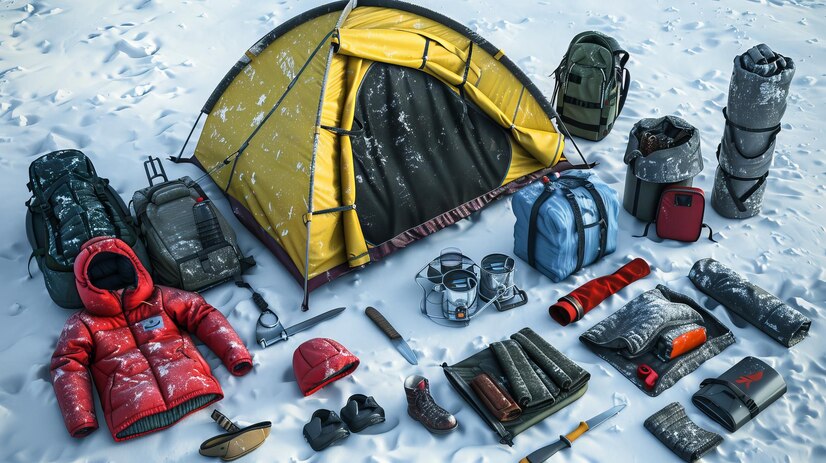
Fall Hike Packing List
Packing the right gear is an essential thing if you want to hike comfortably, safely, and prepared for the fall season. The autumn weather conditions are hard to predict, and trails present other difficulties and some other unique challenges than those in other seasons. Here is a detailed guide on what you should pack for a fall hike, with easy-to-understand explanations to make sure that you are all set for the adventure.
Layers of Clothing
Fall weather is super changeable; therefore, layers are essential-wear layers. Layered clothing traps heat and allows you to keep your body at temperature even in high movements during hiking.
- Base layers: Moisture-wicking Start with a moisture-wicking base layer made from materials such as merino wool or synthetic fabrics such as polyester and elastane, rather than cotton. These wick moisture away from the skin, and you’ll stay dry and warm. Avoid using cotton because it retains moisture and can make you cold if wet.
- Insulated mid-layers: These mid-layers in the form of a fleece jacket or down vest keep you warm. In essence, mid-layers provide insulation as they trap your body heat inside and keep warming you up when the temperatures become extremely low.
- Waterproof outer layer (jacket): Pre-fall weather conditions usually consist of rain or morning dew. It would be very important to have a waterproof and breathable jacket. The jacket must be able to keep you dry without trapping the sweat inside it. Keep in mind that it’s light enough to pack when you don’t need it for a while.
Trekking Boots with Good Grip
You may get autumn tracks to be slippery due to fallen leaves, wet grass, and morning dew. Tread and waterproof features are really important for hiking boots. You should opt for those offering you an opportunity for:
- Good grip: This may help you avoid slipping on slippery or uneven grounds.
- Waterproofing: Generally, autumn has experiences of rain so, getting hold of waterproof boots will save your feet from moisture.
- Ankle support: There are some trail sections that, really rough or muddily wet, require a boot with high levels of ankle support to prevent an injury from twisted or fallen ankles. 3. Headlamp or Flashlight
Many times, when the days are shortening, you find yourself hiking after dark. You will never go without a headlamp or flashlight again because of course that is what you use to see by when the light fails. A headlamp is particularly nice as it allows your hands to remain free. Be sure to carry extras for both in case you lose all power.
Snacks and Water
It’s crucial to stay hydrated and powered throughout the hike, even on cooler days. The coolness of autumn can even mask dehydration, so always bring plenty of water. Snacking;
- Energy bars: These are a quick and easy snack that will often give you a good mix of proteins, carbs, and fats.
- Nuts and dried fruit: These are lightweight and can be very energy-dense, making them an excellent choice for refueling on the trail.
Navigation Tools
Whether you are familiar with a trail or venturing into a new one, you should have navigation tools.
- Handheld GPS: A GPS that helps you point where you are. For this, this will guide you throughout the trail.
- Trail map: A paper map to help support you if your GPS is not available.
- Compass: If you are versed with using it you can manage with it when other gadgets are not there.
First-Aid Kit
Accidents may strike anyone while hiking, so it is important to have a first-aid kit with the very basic supplies to treat small injuries such as:
- Bandages for cuts or blisters.
- Antiseptic wipes to clean the injury.
- Prescription medications such as an inhaler or epinephrine auto-injector if you suffer from allergies. A lightweight compact kit will do you well without weighing you down.
Backpack Rain Cover
Rain showers are quite frequent during fall and can easily take you by surprise. A rain cover for your backpack is one of the simple, yet effective, solutions to keeping your gear dry when it rains. These are light and can be fitted over your pack when necessary .
Trekking Poles
Trekking poles are especially useful on uneven or mountainous terrain, which is particularly common in autumn when the trail is carpeted with foliage. They assist
- Stabilize you on slippery surfaces, reduce your risk of falls.
- Distributes weight more evenly, giving a better balance and support especially when carrying a heavy pack.
Camera or Phone for Photos
The falling of Autumn’s foliage is gorgeous and should be caught. It could either be the bright red, yellow, and orange leaves or the misty morning fog that you ought to remember the great views. You should go equipped with a camera or smartphone to take pictures of the landscape and wildlife. When using your phone, make sure it is fully charged or equip yourself with a portable charger for rapid depletion by the cold.
Quick Summary of What to Pack
- Base layers: This includes moisture-wicking base layers, insulated mid-layers, and a waterproof jacket.
- Good grip for hiking boots: A pair of waterproof, comfortable boots with ankle support.
- Headlamp or flashlight: An essential item when faced with low-light conditions, extra batteries included.
- Snacks and water: Energy bars, nuts, dried fruit, and abundant amounts of water for replenishment.
- Navigation tools: A GPS device and either a trail map or compass.
- First aid kit: Pack bandages, antiseptic, and your personal medications.
- Backpack rain cover: This will protect your gear when you encounter an unexpected rainstorm.
- Trekking poles: To stabilize while walking on uneven terrain.
- Camera or phone: To capture some amazing fall foliage.
By lugging these necessary items, you will be prepared for your fall hike no matter the weather. You are going to take in all that fall foliage, push yourself along a difficult path, or simply enjoy the crisp air you will have everything you need for a fun and safe experience. Happy hiking!
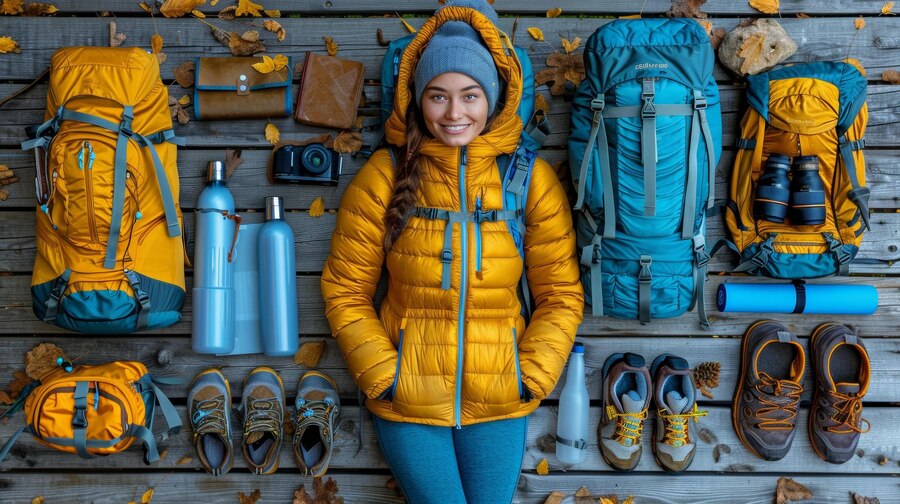
Winter Camping: A Cozy Guide to Cold-Weather Camping
Winter camping is a complete experience. While the cold temperatures seem like a reason to stay indoors, embracing the outdoors during the winter months brings incredible rewards—clear skies full of stars, crisp air, and peaceful beauty of snow-covered lands. If you plan on camping during winter, prepare very well because the weather calls for special equipment and preparations. Step-by-step winter camping steps are presented here below.
The right gear for winter camping
The right gear is essential in winter camping because the cold weather can involve numerous challenges. Here is the list of the essential equipment you will require to be warm, dry, and comfortable in your trip.
4-Season Tent
A regular tent may not cut it to the harsh winter elements. That is where a 4-season tent is used. These are tents specifically designed to hold heavy snow, strong winds, and freezing temperatures.
- Why it’s important: In winter, you will need a tent that will protect you from the cold, prevent snow from coming inside, and offer additional stability against strong winds.
- Features to look for: Strong poles, a low-profile design to reduce wind resistance, and a snow skirt that keeps the tent sealed.
Insulated Sleeping Bag
For winter camping, your best friend is a sleeping bag because when temperatures drop, you’ll want to rely on this for warmth. A sleeping bag rated well below freezing is a requirement, preferably 20°F (-6°C) or lower, depending on the expected temperature.
- Why is that important? An insulated sleeping bag traps your body heat from seeping out into the night, thereby making you warmer in extreme cold.
- Tip: Bags with down insulation will provide maximum warmth-to-weight ratio or better moisture-resistant synthetic insulation, which is more relevant in damp conditions.
Sleeping Pad
- In winter, sleeping bare on cold ground is not very comfortable and may even cause loss of body heat. A sleeping pad would serve as the warm insulation between you and the cold ground.
- Importance: A thick insulated pad ensures that no cold reaches you and at the same time, offers cushioning for a comfortable night’s sleep.
- Tip: Use a two-pad system—a slim foam pad for added warmth under a bulkier air pad.
Portable Stove and Fuel
You won’t be able to cook out in the open as you do during warmer weather, but it is crucial to have a portable stove to heat your meals and drinks. It is also useful to melt snow into drinking water.
- Why it’s important: Winter temperatures may freeze your water sources. A stove provides a way to melt snow into drinkable water. It also facilitates cooking in extremely cold temperatures, as an open flame may be more difficult to maintain in windy, snowy conditions.
- Important tip: Liquid fuel stoves are best suited for cold weather; canister stoves have difficulty working in freezing temperatures.
Clothing Layers
Layering is most significant to keep warm in winter. Clothing layers must allow regulation of body temperature while at the same time keeping one dry and warm. A common layering system includes three layers:
- Base Layer (Moisture-Wicking): Base up with a base layer that wicks away moisture, constructed from merino wool or synthetic fibers. These would ensure that sweat does not draw away from the skin and keep you from getting chilled.
- Insulating Layer (Fleece or Down): You would wish to have an insulating layer that is warm, which can be fleece or down. The above will raise your body heat, thereby not letting your temperature go down
- Outer Shell: Waterproof and Windproof—The outer layer of the jacket should be waterproof and windproof. It should preferably be against snow, rain, and wind. You are good using Gore-Tex Jackets or other breathable waterproof materials.
Gloves, Hat, and Socks
In winter time extremities of your body, such as hands, feet, and head, become cold very quickly. Pack:
- Gloves: Wear well-insulated gloves or mittens; mittens are warmer because fingers stay together.
- Hat: A hat made of wool or fleece can be a beanie or balaclava to keep the head warm.
- Socks: You can obtain either wool or synthetic socks. Wool retains its warmth and shifts moisture far from the feet that has an important role in keeping your feet dry and warm.
Hand and Foot Warmers
When it starts getting extremely cold, sometimes you need to just do whatever it takes to ensure that you keep your extremities from freezing. Hand warmers and foot warmers are small packs that, when activated, produce their own heat, and would make all the difference.
- Importance: They will give you instant heating and warm your hands and feet for many hours, especially when you are upright or resting outdoors in the cold.
Snow Shovel
A snow shovel is one of the important gears while winter camping if you are going to a very deep snow area. You will need it to make a clearance in your tent space, windbreaks, or dig a pit to keep your camp from the wind.
- Why it’s important: A shovel will clear your snow, making your camp more livable and keeping you safe in the event you have to dig out of deep snow.
Headlamp with Extra Batteries
In the winter months, the shorter days make it easy to be out on hikes or setting up camp at dark, so a headlamp is important for visibility and convenience.
• Why it’s important: One headlamp lets you keep your hands completely free to conduct activities such as while setting up camp, cooking, or navigating. Cold temperatures will burn through batteries in no time, so it is always wise to carry extra batteries and/or a spare headlamp.
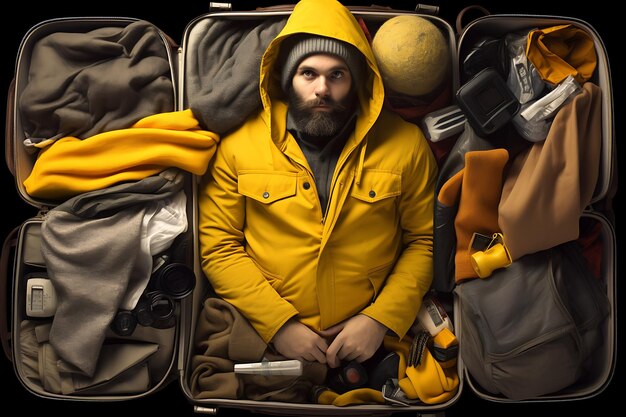
Practical Tips on Being Warm and Safe in Cold Weather
Be warm and safe in cold weather while camping; it’s the only way you’ll be able to have a fun and comfortable adventure. For if you’re not prepared, cold temperatures can be dangerous. But with all the right strategies, you’re going to be nice and safe. Here are some practical tips for you to thrive in chilled conditions:
Choose Your Campsite Wisely
Location is everything when erecting the camp; you should be in sheltered locations while camping during cold weather. You should, therefore, opt for natural areas that can provide some form of windbreak such as near some trees or hills. Natural barriers will protect you from the cold winds that can drop the body temperature quite fast.
- Why it matters: Wind is one of the important factors contributing to heat loss, especially in colder environments. Shelter from the wind would make a big difference at the campsite for warmness.
Layer Up Strategically
Layering is the most crucial point of cold weather. Though, sweat might cause loss of body heat. While you are sweating, then perspiration may penetrate to your clothes and turn you chills in no time. Adjust your layers of clothing depending on your activities and temperature levels.
- Base Layer: Wear a moisture-wicking base layer that is either merino wool or synthetic. This layer should keep the sweat off your skin.
- Insulating Layer: The middle layer is fleece or down that traps the body’s heat.
- Outer Layer: Put on a waterproof and windproof jacket to protect you from the elements.
- Why it matters: Each layer traps the heat without making you overheat and sweat. You might get uncomfortable and may even become colder.
Drink More Water
With the perception that it’s freezing outside, everyone tends to forget to drink water, but hydration is equally important in the winter as much as during the summers as well. During cold conditions, your body loses moisture majorly by breathing and skin. Dehydration can result in physical exhaustion which makes you feel that you do not want to keep warm.
- Why it matters: You may find yourself unmotivated to drink liquids when the weather is cold, but dehydration can compromise your physiological function and heat generation ability by lowering your body temperature, thus increasing your risk of frostbite and hypothermia.
- Tip: Drink warm fluids such as herbal teas or hot chocolate to help maintain your core temperature.
Consume High-Calorie Foods
Your body works more in cold weather to heat you up, hence requiring more calories. It is, therefore important to take calorie-rich meals that will give the body the energy it needs to produce heat.
- Why is it important? Carbs, fats, and proteins will give you good, sustained energy to keep your body warm. Avoid light foods and foods that have far too much sugar, as these don’t contribute to any real endurable energy.
- Tip: Pack energy-dense foods like nuts, cheese, dried meats, and dehydrated meals that are easy to cook and provide plenty of fuel.
Sleep Smart
Sleeping in cold weather requires extra preparation. Your sleeping bag is your most important piece of gear here. To stay warm, consider using a hot water bottle placed inside your sleeping bag to provide extra warmth.
- Why it’s important? You lose a huge amount of heat when you lie there for hours. The hot water bottle keeps you at a warm core temperature all night long.
- Tip: Your sleeping bag must be rated for temperatures lower than you think you might have. Good insulation of the sleeping pad will also stop the cold from moving up from the ground.
Keep Your Extremities Lubricated
The parts of your body that lose heat fastest in cold weather include the hands, feet, and head. These body parts are covered first with warm clothing since their extremities will lose heat rapidly. Warm wool or synthetic gloves, hats, and socks should be worn. In extremely cold weather conditions, mittens are warm enough to keep fingers joined for warmth.
- Why it matters: Body extremities are usually the first to freeze and chill. Cover and insulate them as much as possible.
- Tip: In case your hands or feet start to freeze, wriggle them around a bit to enhance the flow of blood, and install hand warmers or foot warmers for extra coziness.
Watch out for symptoms of Hypothermia and Frostbite
Cold-weather camping is also dangerous if you are not taking good care of yourself and your friends. Always look for hypothermia and frostbite symptoms. Early signs of hypothermia include shivering, confusion, and slurred speech. Frostbite results in pale, hard, and numb-looking skin.
- Why it’s important: If you experience any of these symptoms, you must respond quickly by warming up the affected body part, moving to an indoor space, or a more warm shelter, and pay a visit to the doctor if necessary.
- Tip: Pack a first aid kit with all the basic supplies and refresh your knowledge of basic first aid for cold-related injuries before you set out.
Tarp
That tarp may just turn out to be your new best friend when it comes to camping in the cold. Under the ground and under your tent, you can place a tarp to create an added layer of insulation between that frozen ground and your sleeping bag.
- Why it’s important: The groundsheet in your tent does not keep the frozen earth out of it. A tarp stops you from touching the frozen earth and contributes to keeping your tent warmer.
- Tip: Make sure your tarp is a little larger than your tent so it covers all this area and does not leave holes through which frozen ground could penetrate.
Prepare for Extra Daylight Hours
Winter days are short. You may not have as much time for hiking, getting camp set up, or preparing meals as you are accustomed to. Plan your activities with an eye towards completing the essential tasks before dark. You should get your tent up and your dinner prepared well before sunset.
- Why it’s important: Less daylight means less time to get these things done; planning ahead of time can help keep you from scrambling in the dark.
- Tip: Get out onto hiking trails early to maximize what daylight is available and carry a headlamp with you in case you’re out later than sunset.
Don’t Forget to Have Fun
While it is important to stay safe and warm, winter camping can also be a season to enjoy the wonders of nature that have had little rain since summer. Enjoy the snowfall, enjoy the stillness, and get memories to tell stories around the campfire.
- Why it’s important: The spirit of adventure is an important part of camping. Winter camping can be a wonderland for those who are dreaming about a magical experience so take time to relax and enjoy the serenity.
- Tip: Enjoy winter with snowshoeing, sledding, or simply gazing at the clean, clear sky of winter.
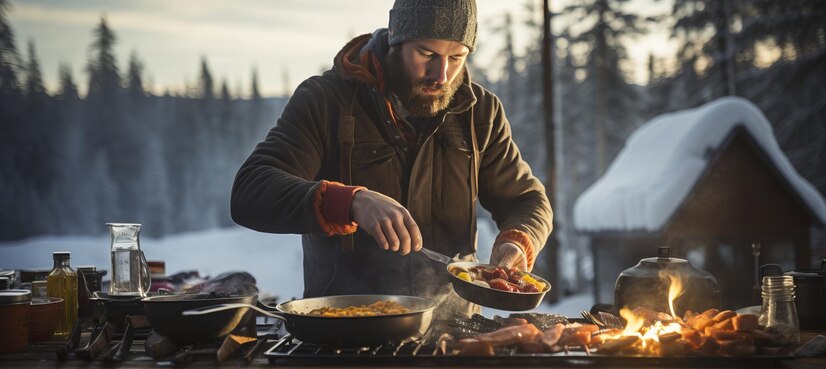
Delicious Winter Camping Easy-to-Cook Recipes
Winter camping is all about staying warm, having fun, and enjoying hearty meals that keep you energized throughout the day. The best part? You don’t need to be a master chef to whip up delicious meals in the wild. Here are 10 easy-to-cook winter camping recipes that will keep you feeling cosy and satisfied:
Campfire Chilli
Ingredients:
- Ground meat (beef, turkey, or beans for a veggie option)
- Canned tomatoes (diced or whole)
- Canned beans (kidney, black, or your favourite)
- 1 onion, chopped
- 2 cloves garlic, minced
- 1 tablespoon chili powder
- Salt and pepper to taste
- Optional: Shredded cheese, sour cream, or crackers for serving
Instructions:
- Heat a pot over your campfire and cook the chopped onions and garlic until softened.
- Add the ground meat (or beans) and cook until browned (if using meat).
- Stir in the canned tomatoes, beans, and chili powder. Add a pinch of salt and pepper.
- Let the chili simmer for about 20-30 minutes, stirring occasionally, until it thickens up.
- Serve hot, and top with cheese, sour cream, or crackers if you like.
Why it’s great: This chili is rich in protein and will warm you up in no time. It’s perfect for cold evenings around the campfire.
________________________________________
Oatmeal with Fruit and Nuts
Ingredients:
- Quick-cook oats
- Dried fruits (raisins, apricots, cranberries, etc.)
- Mixed nuts (almonds, walnuts, cashews, etc.)
- Brown sugar or honey for sweetness
- Optional: Cinnamon or nutmeg for extra flavour
Instructions:
- Boil water in your camp kettle or pot.
- Stir in the quick-cook oats and let them cook for 1-2 minutes, or until the water is absorbed.
- Add the dried fruits, nuts, and a sprinkle of brown sugar or honey.
- For extra flavour, add a dash of cinnamon or nutmeg.
- Stir and enjoy a warm, filling breakfast.
Why it’s great: Oatmeal is easy to make, nutritious, and provides long-lasting energy. Plus, it’s easy to customize with your favourite fruits and nuts.
________________________________________
Hot Cocoa Mix
Ingredients:
- 2 tablespoons cocoa powder
- 2 tablespoons milk powder
- 2 tablespoons sugar
- A pinch of salt
- Hot water
Instructions:
- In a small zip-lock bag, combine the cocoa powder, milk powder, sugar, and a pinch of salt.
- When you’re ready for a hot drink, add the mix to a mug and pour hot water over it. Stir until smooth.
- Optionally, top with marshmallows or a dash of cinnamon.
Why it’s great: Hot cocoa is the ultimate camping comfort drink. It’s quick to prepare and incredibly soothing after a long day in the cold.
________________________________________
Campfire Stew
Ingredients:
- Stew meat (or chicken)
- 4 potatoes, peeled and diced
- 2 carrots, sliced
- 1 onion, chopped
- 1 can of diced tomatoes
- 4 cups beef or vegetable broth
- Salt, pepper, and herbs (like thyme or rosemary)
Instructions:
- In a large pot over the fire, cook the stew meat (or chicken) until browned.
- Add the chopped onion, diced potatoes, carrots, and herbs. Stir to combine.
- Pour in the diced tomatoes and broth. Season with salt and pepper.
- Let the stew simmer for 45 minutes to an hour until the vegetables are tender and the stew thickens.
- Serve hot, and enjoy with some crusty bread.
Why it’s great: This stew is packed with nutrients and will fill you up on the coldest of days. It’s hearty and satisfying.
________________________________________
One-Pot Pasta
Ingredients:
- Pasta (any kind)
- 1 can of diced tomatoes
- 1/2 onion, chopped
- 1 clove garlic, minced
- 1 tablespoon olive oil
- Salt, pepper, and dried herbs (basil, oregano)
- Optional: Grated cheese for topping
Instructions:
- In a pot, heat the olive oil and sauté the chopped onion and garlic until soft.
- Add the canned tomatoes and season with salt, pepper, and herbs.
- Add water to cover the pasta, and bring to a boil.
- Stir in the pasta and cook until the pasta is tender (about 8-10 minutes).
- Top with grated cheese if desired and serve.
Why it’s great: A quick, simple, and filling meal. You can make it in one pot, so cleanup is a breeze.
________________________________________
Grilled Cheese Sandwiches with Tomato Soup
Ingredients for the sandwiches:
- Bread
- Butter
- Cheese slices
Ingredients for the soup:
- 1 can of tomato soup
- Water or milk (to thin the soup)
- Salt and pepper to taste
Instructions:
- For the soup: Heat the tomato soup in a pot, adding water or milk to reach your desired consistency. Season with salt and pepper.
- For the sandwiches: Butter the bread and place cheese between two slices.
- Grill the sandwiches in a skillet over the campfire until golden brown and the cheese is melted.
- Serve the grilled cheese with the hot tomato soup.
Why it’s great: Classic comfort food that’s easy to make and perfect for warming up in the winter chill.
________________________________________
Campfire Nachos
Ingredients:
- Tortilla chips
- Shredded cheese
- Canned beans (black beans or kidney beans)
- Salsa
- Sour cream (optional)
Instructions:
- Layer the tortilla chips in a cast-iron pan or skillet.
- Sprinkle with shredded cheese, beans, and salsa.
- Cover with foil and cook over the campfire or on a grill for 10-15 minutes until the cheese melts.
- Serve with a dollop of sour cream.
Why it’s great: A fun, shareable snack or meal that’s quick to prepare and loaded with flavour.
________________________________________
Campfire Baked Potatoes
Ingredients:
- Large potatoes
- Olive oil
- Salt and pepper
- Optional: Butter, sour cream, cheese, chives
Instructions:
- Wash and scrub the potatoes, then coat them with olive oil, salt, and pepper.
- Wrap each potato in foil and place them on the campfire coals.
- Cook for 30-45 minutes, turning occasionally, until they’re tender.
- Unwrap and top with your favourite toppings like butter, cheese, and sour cream.
Why it’s great: A filling, easy-to-make meal that’s perfect for any camping trip.
________________________________________
Campfire Quesadillas
Ingredients:
- Flour tortillas
- Shredded cheese
- Pre-cooked chicken or beans
- Salsa
Instructions:
- Lay a tortilla on a flat surface and sprinkle with cheese, chicken, and a spoonful of salsa.
- Top with another tortilla and cook over a campfire grill or skillet until golden brown and the cheese is melted.
- Slice and serve hot.
Why it’s great: A tasty, handheld meal that’s perfect for a quick dinner or snack by the fire.
________________________________________
Crispy Campfire Pancakes
Ingredients:
- Pancake mix (just add water type)
- Water
- Butter or oil for frying
- Maple syrup
Instructions:
- Mix the pancake batter according to the instructions on the package.
- Heat butter or oil in a skillet over the campfire.
- Pour the pancake batter into the skillet, cooking until golden brown on both sides.
- Serve with maple syrup and enjoy.
Why it’s great: Pancakes are a classic camping breakfast that’s easy to make and delicious with a hot cup of coffee.
________________________________________
These winter camping recipes are simple, warming, and perfect for cooking over an open fire or on a portable stove. Whether you’re making a hearty stew or enjoying a cup of hot cocoa, these meals will keep you feeling cosy and content throughout your camping adventure. Enjoy!These winter camping recipes are simple, warming, and perfect for cooking over an open fire or on a portable stove. Whether you’re whipping up a hearty stew or enjoying a cup of hot cocoa, these meals will keep you feeling cozy and content all your camping adventure. Enjoy!

Weather-Wise: Best Locations for Fall Hiking and Winter Camping
Some of the most beautiful hikes entail choosing a location that will be perfect during your fall hike or your winter camping adventure. While every season is uniquely magical, some destinations showcase stunning scenery to immerse yourself in the beauty of the outdoors. So, here are three fantastic places for fall hiking and winter camping that will have you making unforgettable memories and views.
Blue Ridge Parkway, USA (Fall)
Why it’s great for fall hiking:
- The Appalachian Mountains home the Blue Ridge Parkway. A stretch that runs along this mountain offers breathtaking views of the lavish fall colorful foliage. Cooler temperatures with clear skies offer an ideal location to enjoy the comfort of an enjoyable hike.
- Hiking during the fall season: The fall season has great cool morning air and moderate daytime temperatures, thus excellent for hiking. The air is crisp and rejuvenating with the sceneries between deep greens and fiery reds, oranges, and yellows as the trees change color.
What to Expect
- Fall Color: The fall colors along the Blue Ridge Parkway are famous. By mid-September to early November, the leaves start turning to form a kaleidoscope of colors with perfect picture results.
- Popular trails: There are many trails within the Parkway, ranging from very easy to more strenuous hiking trails. Among the options preferred by the hikers are Hawksbill Mountain Trail and Linville Gorge for their fabulous views and serene atmosphere.
Tips:
- Layer clothes: It’s going to be cold in the mornings and evenings but warm during the day, so layer clothes.
- Camera: Take a camera as you’ll have enough to click with the fall colours- and don’t forget extra memory cards, as you’ll want to keep snapping pictures.
________________________________________
Mont-Tremblant, Canada (Fall)
Why it’s great for fall hiking:
- Most popular hiking spot in the province of Quebec, especially to enjoy the fall season at the time when the region is beautifully covered with rich autumn color. It is located in Laurentian Mountains and is really great for outdoor activities involving hiking amidst beautiful forests.
- Cooler weather: As fall arrives, Mont-Tremblant begins to notice the cooler conditions, therefore one will need to layer them warmly, especially in the morning and evening. The freshness of the crisp air also brings such colors to life, but it does this great justice in bringing moderate temperatures during the day for hikes.
What to expect:
- Spectacular fall colors: The surrounding forests of maple, oak, and birch trees show most vibrant reds, oranges, and gold. The views are nothing but a photographer’s dream.
- Mountain trails: Mont-Tremblant offers various hiking trails for all levels: easy loops around the base of the mountain to steeper trails getting you up to panoramic views in the valleys and the forests.
Tips:
- Extra clothing: No one can predict the weather, so pack layers of clothes that you can easily add to or remove according to your needs.
- Hydration: The cooler may cause forgetfulness in drinking enough water; however, keep a water bottle handy.
______________________________________
Black Forest, Germany (Winter Camping)
Why Camp there During Winters:
- Black Forest (Schwarzwald) is one of the most beautiful winter destinations in Europe, lying in southwest Germany. With dense, snow-covered trees and pretty small villages accompanied by relatively silent forests, it offers a very interesting winter camping experience to all those planning a quiet stay during the winter season.
- Winter magic: Thick snowfall that encases the forest and all the peaks together with the freezing cold air offers a mystery all around winters here. Black Forest has a serene and slightly mystical character which makes for an incredibly special camping visit.
What to expect
- Snow-covered trees: Imagine to sleep under snow-drifted pine woods while a thick layer of snow covers the ground. Wintry beauty is noted to be in the Black Forest, and the forest silence and quiet will bring peace in your busy schedule.
- Charming winter villages: The Black Forest has very small, charming villages that look like they were taken right out of a fairy tale: cobblestone streets and traditional half-timbered houses. These villages would be perfect to pull over for hot cocoa or warming meal after a day’s winter camping.
Tips:
- Prepare for cold temperatures: Winter in the Black Forest is extremely cold. Temperatures often go below freezing, so be prepared with insulated clothing, four-season tents, and warm sleeping bags.
- Prepare for snow: Prepare for snow and ice, especially if planning to venture into more remote areas. A shovel and winter traveling equipment like spikes would be essential for safety.
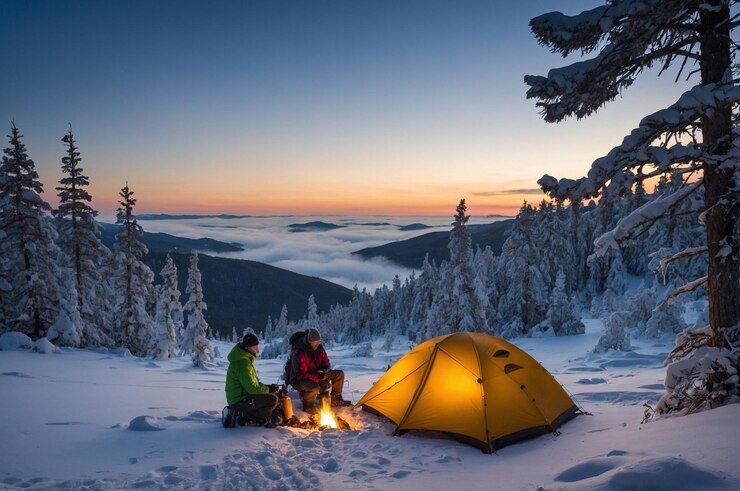
General Tips for Fall Hiking and Winter Camping
Fall Hiking:
Layer up: It is an essential aspect of fall hiking because the temperature might shift while hiking during the day.
Be prepared for rain: The fall season is very unpredictable so be prepared with a waterproof jacket or poncho if you get caught unawares.
Trail safety: Due to fallen leaves, some paths will be slippery because the leaves may cover parts of the trail. Be careful with your steps.
Winter Camping:
Bring the right gear: A good winter tent, a sleeping bag that rated for freezing temperatures, and dozens of layers to ensure you stay warm.
Check weather forecasts: Winter conditions change in a single day so it is important to stay updated on such weather reports for safety.
Light and warmth: Since winter days are shorter, a reliable headlamp with extra batteries is important for circumspection around camp. A portable stove can be used to prepare your meal and melt snow for drinking.
________________________________________
Whether hiking through the colorful autumn foliage of Blue Ridge Parkway or experiencing snowy peace in Black Forest during a winter camping tour, you have something special here for every adventurer. Prepare the right equipment and be ready for the beauty each season has to offer!
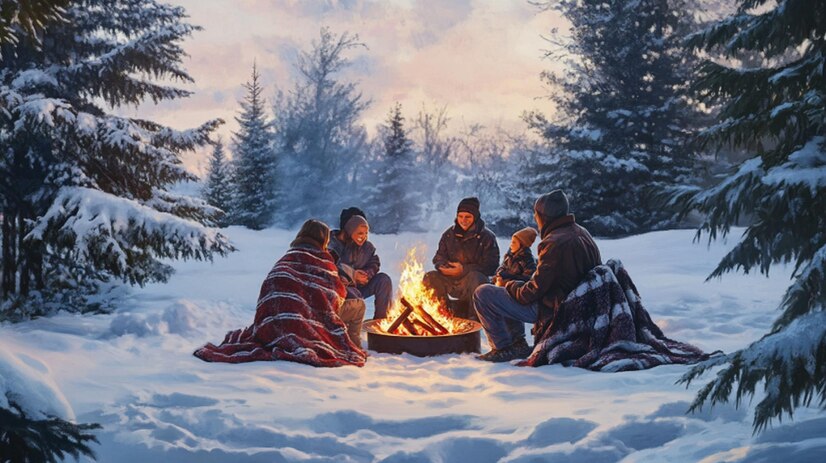
Conclusion
Whether you’re off hiking the fall colors along the Blue Ridge Parkway or camping serenely under snow in the winter black forest, nature has a beauty in every season. The fall as well as the winter have different experiences out in nature, and with proper preparation, each experience can be improved on. With the right selection of locations, packing the right gear, and knowing the conditions, you can end up creating memories that are most unforgettable in the great outdoors.
Preparation is always key to any great adventure. Be it tackling mountain trails or enjoying the stillness of winter forests or simply basking in the natural beauty surrounding you, these seasons have something magical to offer every outdoor enthusiast.
20 Frequently Asked Questions (FAQs)
- When are the best times to go on a fall hike?
It is generally mid-September through early November, but it varies by location and, obviously, weather conditions.
- How to keep warm while winter camping?
This includes layering of clothes, using an insulated sleeping bag, and ensuring that one packs enough warm accessories like gloves, hats, and thermal socks. A hot water bottle can also help keep one warm during night.
- What equipment must I pack for winter camping?
Minimum kit is a four-season tent, an insulated sleeping bag, a sleeping pad, portable stove, warm clothing layers, gloves, and headlamp, spare batteries.
- How do I prepare for unpredictable weather during my fall hikes?
Always check the forecast of the weather before your hike, and build up with layers, a waterproof jacket, and packs of extra clothing. Expect that the situation may change rapidly with temperature and rain showers.
- Is it safe to camp in winter?
With proper gear, planning, and preparation for extreme conditions, it can be safe for winter camping. Check the weather report and keep it within your skill level.
- What are the best foods to take for fall hiking and winter camping?
High-energy snacks – and these are nuts, energy bars, dried fruits, and trail mix-are great for some hikes. For camping, try foods such as campfire chili, oatmeal, or soups that can be easily cooked with a portable stove.
- How to Prevent Dehydration in Cold Weather?
Even if you do not feel a need to drink water, it is always recommended to do so sometimes. The cold, dry air sometimes causes dehydration even without your awareness. So be prepared for the journey carrying sufficient amounts of water.
- What will I do if I fall or run into wild animals while out on a hike in the winter?
Stay calm and avoid entry into their space. Make noise to avoid startling any animals, and never approach them. If you are in a place with larger wildlife, be sure to carry bear spray or other necessary safety gear.
- How can I be safe on icy or snowy trails?
Wear shoes and clothes that have good grip, and consider carrying some microspikes or crampons for better grip on icy surfaces. Be quite cautious on slippery trails while hiking.
- Am I Able to Hike in Winter?
Yes, but winter hiking does not come easily. Choose an appropriate trail that has the best conditions to be handled during winter and ensure that you have the proper equipment, such as insulated clothing, and good boots.
- What If I Get Lost?
If I find myself lost during a winter hike:
Re-center yourself and attempt to backtrack to camp. Use a compass or your GPS unit to help guide you back home. Always notify a friend or family member of your route beforehand, and always carry a map or some other kind of digital navigation.
- How do I make campfire chili in the wilderness?
To make campfire chili, cook ground meat or beans with onions, garlic, canned tomatoes, and chili powder in a pot over your campfire. Simmer until thick, and enjoy with bread.
- How do I keep my camera or phone warm during winter?
Cold weather drains batteries rapidly. Put your phone or camera in an inside pocket to keep them warm, and carry some extra batteries so that you don’t run out of power.
14. What’s the best way to avoid frostbite while winter camping?
Dress your extremities in insulated gloves, socks, and boots. Avoid wetness. Keep moving to maintain blood circulation. Warm up the affected body part if you begin feeling numbing.
15. How do I ensure that my tent is kept warm while winter camping?
Find a snow-sheltered place to make camp where wind isn’t a concern and orient your tent to minimize drifting snow on the top. Use a tarp underneath for added insulation, and make sure your sleeping bag is made for the cold.
- How do I choose a suitable winter camping site?
Flat, snow-sheltered locations are preferred. Steer clear of low areas where cold air gets caught. Pay attention to snow drifts, as you will be camping with them.
- How do you make the best use of shorter daylight in winter?
Plan your hikes or camping activities according to the daylight hours. It’s best to get out early and have completed all your outdoor activities before sunset.
- What are some ways to avoid frozen water when winter camping?
You keep your water bottles inside your jacket or pack to insulate them. Alternatively, you could opt for a thermos meant for hot beverages, which does not freeze.
- Safety Precautions on Fall Hiking Trails?
Fall hikes are slippery and covered with fallen leaves; tread carefully. Stay away from unused trails, so you get lost, and don’t disturb the wildlife.
- Does some sort of tent support winter camping?
Not all tents are suitable for winter camping. The best option to ensure security during winter is to have a four-season tent, which can withstand strong winds and heavy snowfall.




